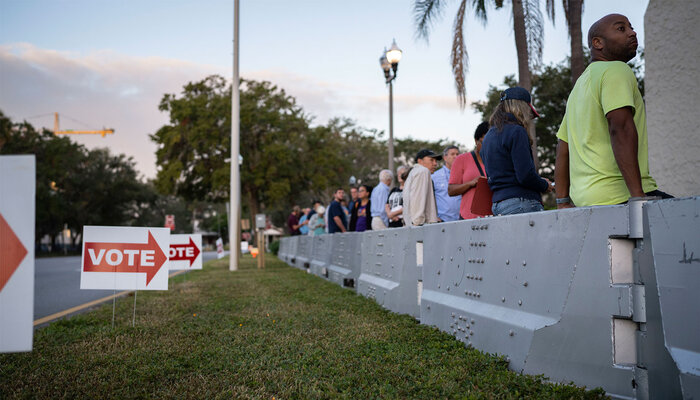Ten years ago this month, the Supreme Court announced its decision in Shelby County v. Holder, sidelining a key provision of the 1965 Voting Rights Act. For nearly 50 years, Section 5 had required states and localities with histories of discriminatory voting practices to “preclear” any changes to their voting systems with the federal government. Shelby County, Alabama, argued that when the landmark civil rights bill was initially enacted, there was ample evidence of the “vestiges of discrimination” that necessitated safeguarding voters of color with the extraordinary tools in Section 5. But over time, the county argued, these conditions no longer existed in Alabama.
The Court’s majority agreed, noting that the racial turnout gap — the difference between white voter turnout Black voter turnout — had closed in the 2008 and 2012 presidential elections. The expectation that this would continue was a key error. Our new analysis shows how the racial turnout gap, which the Court appears to have relied on, has actually increased significantly in Alabama in the 10 years since that decision. The growing gap isn’t confined to Alabama: as we showed last year, the gap has grown substantially in Georgia, and there’s evidence that it’s grown elsewhere, too. This is unfortunately not surprising, since discriminatory lawmaking is far from a relic confined to the past, as several friend-of-the-court briefs detailed in 2013 and Brennan Center research showed more recently.
The Court was not wrong to note that the racial turnout gap had narrowed shortly before the 2013 opinion was handed down. In fact, by some measures, national white and Black turnout had reached near parity in the 2008 and 2012 presidential elections, although this was not the case for the turnout gap between white voters and other voters of color (and, as our data shows below, not true in Alabama in 2012). Our data demonstrates that the majority in Shelby County was decidedly wrong, however, to attribute that closure to the eradication of race discrimination in elections. The far more likely explanation was that Barack Obama’s historic presidential nomination led to substantially higher Black turnout.
Of course, as Justice Ruth Bader Ginsburg noted in her dissent, some of the shrinking might have also been attributable to the effectiveness of the Voting Rights Act’s teeth. In any event, once Section 5 was effectively nullified, a torrent of anti-voter legislation was unleashed in states that had previously been required to get federal approval for voting changes. Alabama, for instance, swiftly passed a law that would require a photo ID to vote following the decision, a policy known to increase the racial turnout gap. Coupled with Obama’s absence from the ticket, the aftereffects are plainly evident.
Between the 2012 and 2016 elections, the racial turnout gap more than doubled in Alabama. For Black voters, it grew from 3 percentage points below the white turnout in 2012 to 7 points in 2016. Similarly, the white-nonwhite turnout gap grew from 7 to 10 points between 2012 and 2016. The likely reason for the white-nonwhite gap continually surpassing and breaking away from the white-Black gap is the small but growing Latino population in Alabama.
Apart from 2018, the white-Black turnout gap increased each year from 2012 through 2022. During last year’s election, the white-Black gap was 9 points — triple the size of the gap only a decade ago. Put differently, some 90,000 more Black voters would have participated in Alabama last year if Black turnout had reached parity with white turnout. The white-nonwhite turnout gap remained at 13 percentage points, the same as in 2020 — translating to roughly 150,000 ballots uncast by people of color. While the growing gap likely has many causes in addition to the removal of the guardrails that Section 5 established in states, these trends are nonetheless sobering. The steady trend of progress over five decades toward ensuring voters of color have equal access to the franchise has quickly reversed over the past 10 years.
A decade ago, Chief Justice John Roberts wrote in the Court’s majority opinion that preclearance doesn’t account for “current data reflecting current needs,” and that was reason enough to gut the Voting Rights Act. At the 10-year anniversary of Shelby County, current data shows why formerly covered states like Alabama need federal protections in place to make certain that voters of color are not disenfranchised by discriminatory and retrogressive voting laws.
While this data standing alone cannot prove that the absence of Section 5’s protection is the sole reason for Alabama’s widening racial turnout gap, the finding quite clearly refutes the majority’s assertion that discrimination was only ever a “vestige” in the state. Both in 2013 and now, discrimination enmeshed in the state’s election practices has engendered significant racial differences in the enjoyment of the franchise. With widening turnout gaps in Alabama and around the country, the need for a revitalized Section 5 is pressing.
Data and Methods
In this analysis, we relied on voter-file data provided by the vendor L2 Political. We leverage snapshots following each of the 2012–2022 federal elections; this ensures that the individuals on the rolls are largely, if not perfectly, reflective of actual participants in each year. In Alabama, voters self-identify their race when they register to vote. While L2 included these self-reports in the 2012, 2018, 2020, and 2022 snapshots, they are missing in 2014 and 2016. To supplement the race of the voters in these years, we matched participants in those contests to the 2012 and 2018 voter files. Roughly 97 percent of participants in 2014 and 2016 were in the 2012 or 2018 file; we use BISG to predict the race of the remaining 3 percent of the population. For all years, we use BISG to predict voters’ race if they declined to state their race when they registered to vote or if they marked “other” on their registration form. We use the algorithm provided in the wru package in R but adjust the target population to be Citizen Voting Age Population (CVAP) instead of total population.
In each year, our denominator is the CVAP estimate for the five years ending with the election year. Because 2022 CVAP estimates are not yet available, the 2022 denominator uses the 2021 estimates.






